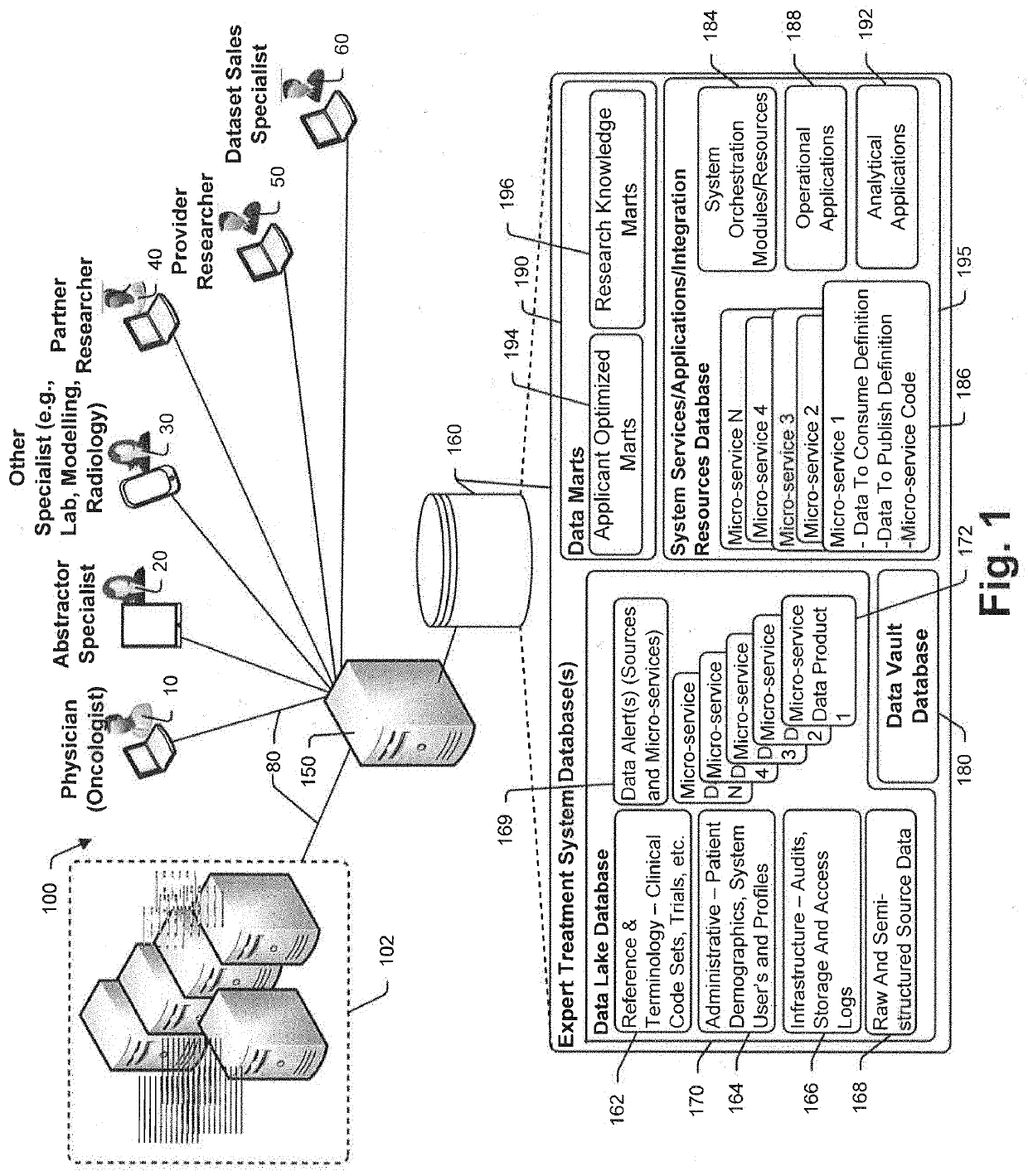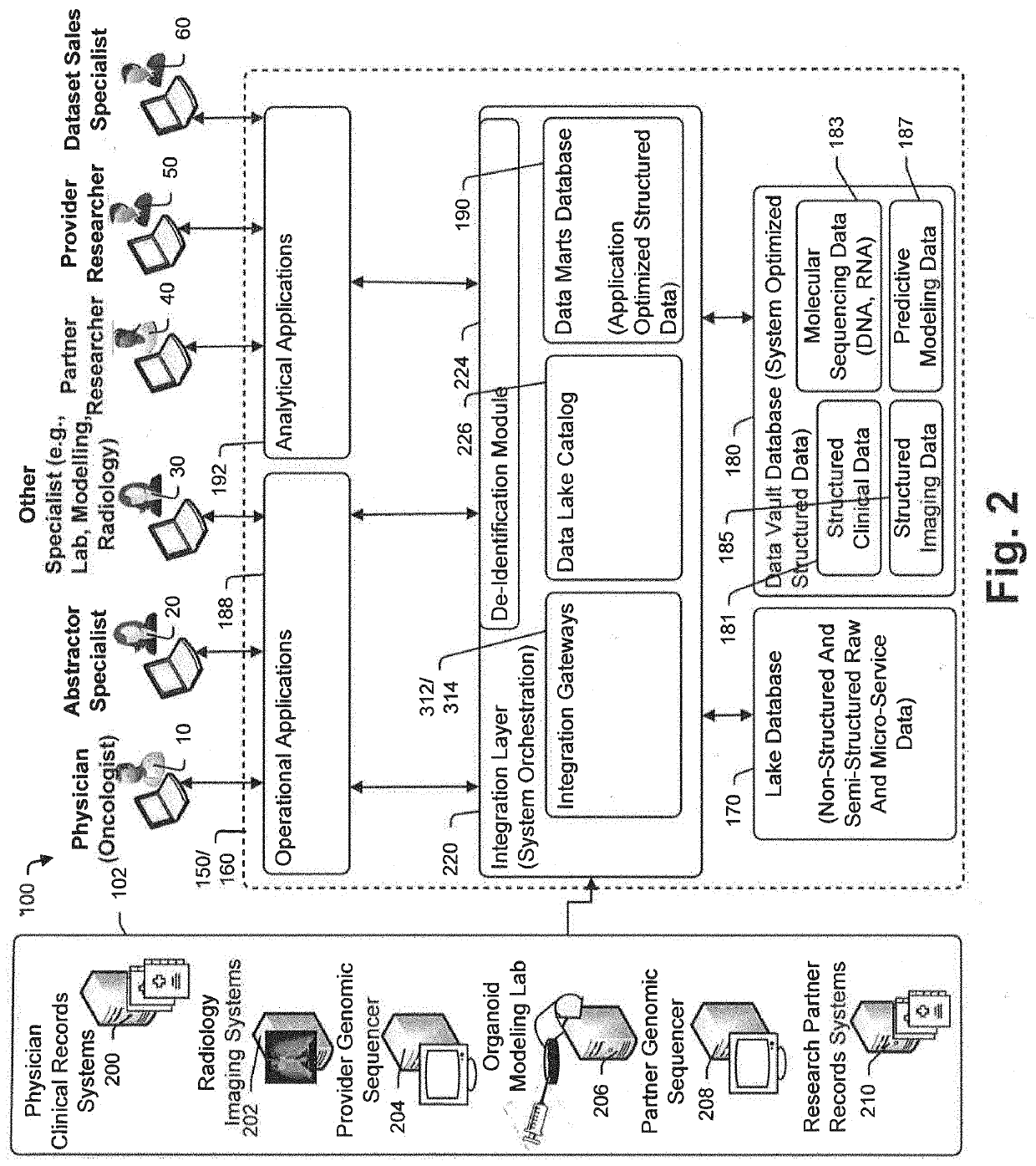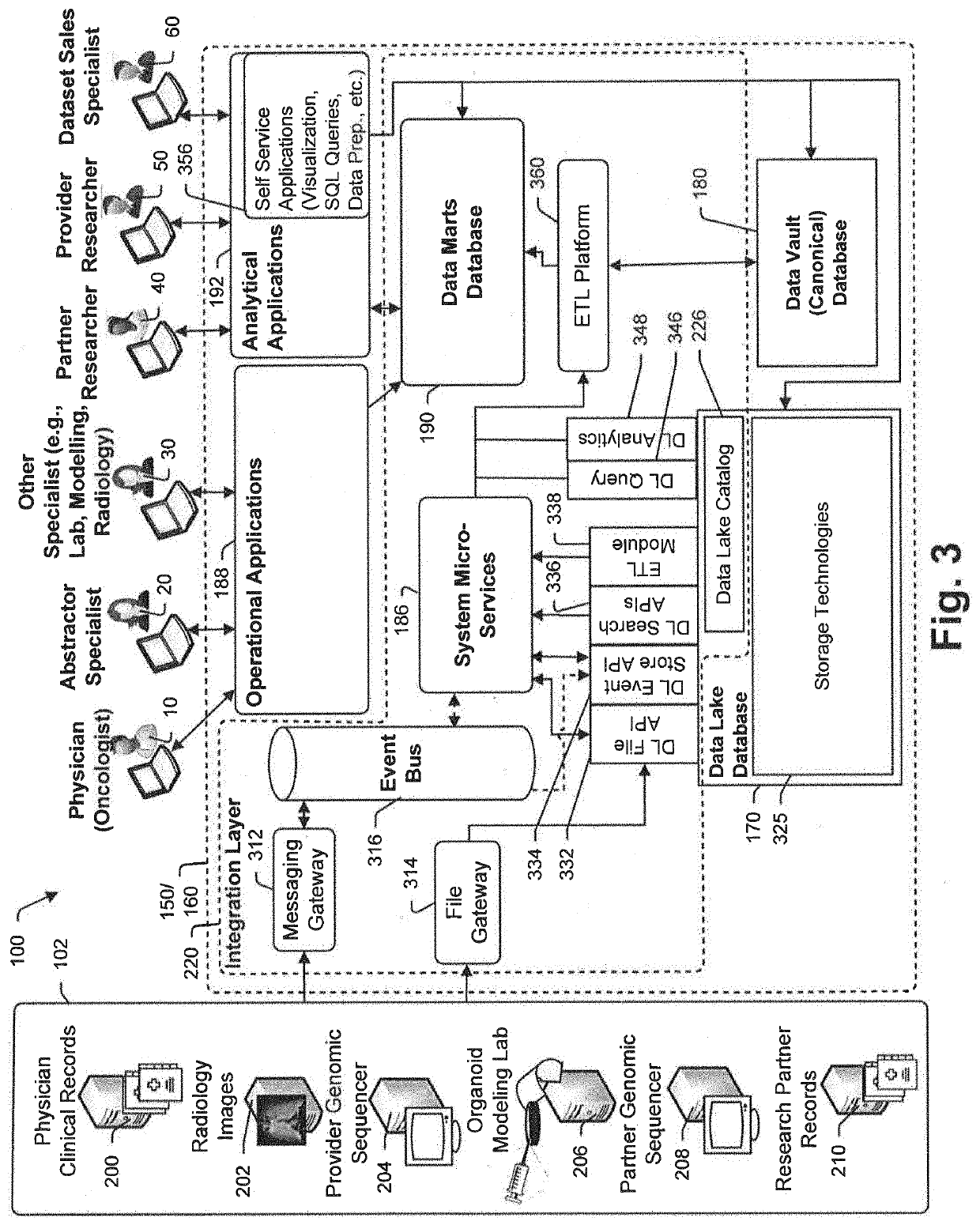In treatment of at least some
cancer states, treatment and results data is simply inconclusive.
Here, the first woman may respond to a
cancer treatment plan well and may recover from
her disease completely in 8 months with minimal side effects while the second woman, administered the same
treatment plan, may suffer several severe adverse side effects and may never fully recover from her diagnosed
cancer.
In these cases, unfortunately, there are cancer state factors that have cause and effect relationships to specific
treatment results that are simply currently unknown and therefore those factors cannot be used to optimize specific patient treatments at this time.
For instance, in one
chemotherapy study using SULT1A1, a
gene known to have many polymorphisms that contribute to a reduction of
enzyme activity in the metabolic pathways that process drugs to fight
breast cancer, patients with a SULT1A1
mutation did not respond optimally to
tamoxifen, a widely used treatment for
breast cancer.
In some cases these patients were simply resistant to the
drug and in others a wrong dosage was likely lethal.
One problem with
genetic testing is that testing is expensive and has been cost prohibitive in many cases.
Another problem with
genetic testing for treatment planning is that, as indicated above, cause and effect relationships have only been shown in a small number of cases and therefore, in most cancer cases, if
genetic testing is performed, there is no linkage between resulting genetic factors and
treatment efficacy.
In other words, in most cases how genetic test results can be used to prescribe better treatment plans for patients is unknown so the extra expense associated with genetic testing in specific cases cannot be justified.
Thus, while promising, genetic testing as part of first-line
cancer treatment planning has been minimal or sporadic at best.
While the lack of genetic and
treatment efficacy data makes it difficult to justify genetic testing for most cancer patients, perhaps the greater problem is that the dearth of
genomic data in most cancer cases impedes processes required to develop cause and effect insights between
genetics and
treatment efficacy in the first place.
Thus, without massive amounts of
genetic data, there is no way to correlate genetic factors with treatment
efficacy to develop justification for the expense associated with genetic testing in future cancer cases.
Yet one other problem posed by lack of
genomic data is that if a researcher develops a genomic based treatment
efficacy hypothesis based on a small
genomic data set in a lab, the data needed to evaluate and clinically assess the
hypothesis simply does not exist and it often takes months or even years to generate the data needed to properly evaluate the
hypothesis.
Here, if the hypothesis is wrong, the researcher may develop a different hypothesis which, again, may not be properly evaluated without developing a whole new set of genomic data for multiple patients over another several year period.
In other cases, however,
treatment results cause and effect data associated with other cancer states is underdeveloped and / or inaccessible for several reasons.
First, there are more than 250 known cancer types and each type may be in one of first through four stages where, in each stage, the cancer may have many different characteristics so that the number of possible “cancer varieties” is relatively large which makes the sheer volume of knowledge required to fully comprehend all
treatment results unwieldy and effectively inaccessible.
Second, there are many factors that affect treatment
efficacy including many different types of patient conditions where different conditions render some treatments more efficacious for one patient than other treatments or for one patient as opposed to other patients.
Clearly capturing specific patient conditions or cancer state factors that do or may have a cause and effect relationship to treatment results is not easy and some causal conditions may not be appreciated and memorialized at all.
The plethora of treatment and customization options in many cases makes it difficult to accurately capture treatment and results data in a normalized fashion as there are no clear standardized guidelines for how to capture that type of information.
Fourth, in most cases patient treatments and results are not published for general consumption and therefore are simply not accessible to be combined with other treatment and results data to provide a more fulsome overall
data set.
In this regard, many physicians see treatment results that are within an expected range of efficacy and conclude that those results cannot add to the overall
cancer treatment knowledge base and therefore those results are never published.
The problem here is that the expected range of efficacy can be large (e.g., 20% of patients fully heal and recover, 40% live for an extended duration, 40% live for an intermediate duration and 20% do not appreciably respond to a
treatment plan) so that all treatment results are within an “expected” efficacy range and treatment result nuances are simply lost.
Fifth, currently there is no easy way to build on and supplement many existing illness-treatment-results databases so that as more data is generated, the new data and associated results cannot be added to existing databases as evidence of treatment efficacy or to challenge efficacy.
Thus, for example, if a researcher publishes a study in a medical journal, there is no easy way for other physicians or researchers to supplement the data captured in the study.
Without data supplementation over time, treatment and results corollaries cannot be tested and confirmed or challenged.
Thousands of oncological articles are published each year and many are verbose and / or intellectually arduous to consume (e.g., the articles are difficult to read and internalize), especially by extremely busy physicians that have limited time to absorb
new materials and information.
Distilling publications down to those that are pertinent to a specific physician's practice takes time and is an inexact endeavor in many cases.
Seventh, in most cases there is no clear incentive for physicians to memorialize a complete set of treatment and results data and, in fact, the time required to memorialize such data can operate as an impediment to collecting that data in a useful and complete form.
To this end, prescribing and treating physicians are busy diagnosing and treating patients based on what they currently understand and painstakingly capturing a complete set of cancer state, treatment and results data without instantaneously reaping some benefit for patients being treated in return (e.g. a new insight, a better prescriptive treatment tool, etc.) is often perceived as a “waste” of time.
Eighth, the field of next generation sequencing (“NGS”) for cancer
genomics is new and NGS faces significant challenges in managing related sequencing,
bioinformatics, variant calling, analysis, and reporting data.
Different genomic datasets exacerbate the task of discerning and, in some cases, render it impossible to discern, meaningful
genetics-treatment efficacy insights as required data is not in a normalized form, was never captured or simply was never generated.
In addition to problems associated with collecting and memorializing treatment and results data sets, there are problems with digesting or consuming recorded data to generate useful conclusions.
For instance, recorded cancer state, treatment and results data is often incomplete.
In most cases physicians are not researchers and they do not follow clearly defined research techniques that enforce tracking of all aspects of cancer states, treatments and results and therefore data that is recorded is often missing key information such as, for instance, specific patient conditions that may be of current or future interest, reasons why a specific treatment was selected and other treatments were rejected, specific results, etc.
In many cases where cause and effect relationships exist between cancer state factors and treatment results, if a physician fails to identify and
record a causal factor, the results cannot be tied to existing cause and effect data sets and therefore simply cannot be consumed and added the overall cancer knowledge
data set in a meaningful way.
Another impediment to digesting collected data is that physicians often capture cancer state, treatment and results data in forms that make it difficult if not impossible to process the collected information so that the data can be normalized and used with other data from similar patient treatments to identify more nuanced insights and to draw more robust conclusions.
Using
software to glean accurate information from hand written notes is difficult at best and the task is exacerbated when hand written records include personal abbreviations and shorthand representations of information that
software simply cannot identify with the physician's intended meaning.
For this reason, many physicians are not aware of many
treatment options for specific ailment-patient condition combinations, related treatment efficacy and / or how to implement those
treatment options.
While treatment boards are useful and facilitate at least some sharing of experiences among physicians and other healthcare providers, unfortunately treatment committees only consider small snapshots of
treatment options and associated results based on personal knowledge of board members.
In many cases the combined knowledge of board members may not include one or several important perspectives or represent important experience bases so that a final treatment plan simply cannot be optimized.
In the case of cancer treatments where cancer states, treatments, results and conclusions are extremely complicated and nuanced, physician and researcher interfaces have to present massive amounts of information and show many data corollaries and relationships.
When massive amounts of information are presented via an interface, interfaces often become extremely complex and intimidating which can result in misunderstanding and underutilization.
In some cases specific cancers are extremely uncommon so that when they do occur, there is little if any data related to treatments previously administered and associated results.
With no proven best or even somewhat efficacious treatment option to choose from, in many of these cases physicians turn to clinical trials.
A cancer patient without other
effective treatment options can opt to participate in a
clinical trial if the patient's cancer state meets trial requirements and if the trial is not yet fully subscribed (e.g., there is often a limit to the number of patients that can participate in a trial).
Matching patient cancer state to a subset of ongoing trials is complicated and
time consuming.
For this reason, there is always a tension between treatment planning speed and thoroughness where one or the other of speed and thoroughness suffers.
One other problem with current
cancer treatment planning processes is that it is difficult to integrate new pertinent treatment factors, treatment efficacy data and insights into existing planning databases.
In this regard, known treatment planning databases and application programs have been developed based on a predefined set of factors and insights and changing those databases and applications often requires a substantial effort on the part of a
software engineer to accommodate and integrate the new factors or insights in a meaningful way where those factors and insights are properly considered along with other known factors and insights.
In some cases the substantial effort required to integrate new factors and insights simply means that the new factors or insights will not be captured in the
database or used to affect planning.
In other cases the effort means that the new factors or insights are only added to the
system at some
delayed time after a software engineer has applied the required and substantial
reprogramming effort.
Unfortunately, rendering a new insight actionable in the case of cancer treatment is a literal matter of life and death and therefore any
delay or inaccurate application can have the worst effect on current patient prognosis.
One other problem with existing cancer treatment efficacy databases and systems is that they are simply incapable of optimally supporting different types of system users.
In known systems,
data access, views and interfaces are often developed with one consuming
client in mind such as, for instance, physicians, pathologists, radiologists, a cancer treatment researcher, etc., and are therefore optimized for that specific system user type which means that the system is not optimized for other user types and cannot be easily changed to accommodate needs of those other user types.
However, the routine use of NGS testing in a clinical context faces several challenges.
First, many tissue samples include minimal high quality
DNA and
RNA required for meaningful testing.
Exacerbating matters, many samples available for testing contain limited amounts of tissue, which in turn limits the amount of
nucleic acid attainable from the tissue.
 Login to View More
Login to View More  Login to View More
Login to View More 


